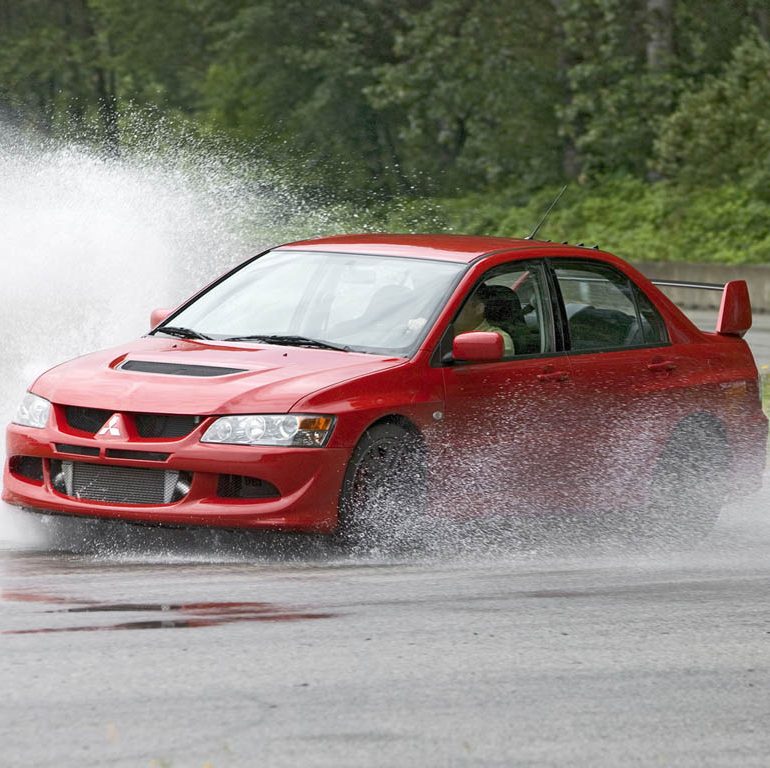2005 Mitsubishi Lancer Evolution VIII MR
October 18, 2004 — Cypress, Calif. — When the Lancer Evolution debuted in North America in 2003, it did something extraordinary: it lived up to the hype. ”The Evolution proved that Mitsubishi not only could compete with the best performance cars in the world, but that we could offer something most performance cars don’t,” said Ian Beavis, senior vice president of marketing for Mitsubishi Motors North America (MMNA), ”And that’s value.”
Not content to rest on past achievements or awards, Mitsubishi continues to refine one of Japan’s best-handling, competition-derived production cars. Finding room for improvement was no small task, so Mitsubishi turned to one of the world’s most rigorous circuits, the Nurburgring.
The Nurburgring Nordschleife is notorious for its bumpy and undulating surfaces, twisting corners and changes in surface friction. It was there that engineers discovered one potential area of improvement for the Lancer Evolution. As the result of years of development focused on ride and handling, Mitsubishi introduces the next level Lancer: the MR Edition.
MR Edition
The tradition of the high-performance Mitsubishi Racing moniker dates back to 1970, with the Mitsubishi Galant GTO MR, Mitsubishi’s first production car powered by a DOHC engine that boasted 125 horsepower. So while times, and engine outputs, have changed, Mitsubishi’s commitment to performance has not.
Building on the Lancer Evolution’s rally-proven reputation, the MR Edition pushes the performance envelope even further with improvements to the crucial elements that make driving a true pleasure. Engine output was increased, but more power was not the top priority. Although the recent meteoric rise of horsepower figures seems to be the top selling point for many new vehicles, Mitsubishi focused its development efforts on the intricate coordination between engine output and handling performance.
Performance
The Evolution MR Edition features several enhancing features: a lightweight aluminum roof panel (a first for a Japanese production model), designed to lower the center of gravity and reduce the roll moment; jointly developed Bilstein monotube shock absorbers to improve road holding; and new lightweight forged alloy wheels courtesy of BBS(R).
On all Lancer Evolutions, the 2.0-liter inline four-cylinder DOHC intercooled-turbocharged engine is tuned to deliver maximum power over the mid- to high-rev band, generating 286 lb-ft of torque at 3500 rpm. Horsepower also has increased – from 271 to 276 hp, available at 6500 rpm.
As an exclusive for the MR Edition, a six-speed transmission makes the power more accessible. The Evolution’s AWD system gains an Active Center Differential (ACD) and front limited-slip, which – combined with Sports ABS – creates a more natural, better-mannered driving feel. Man and machine have never been so intimately linked.
Interior
As a reminder of what’s just overhead, the Evolution MR Edition adds an aluminum shift knob; an aluminum and carbon fiber brake lever handle; and aluminum pedals. The track-tuned Evolution RS also benefits from the newly available aluminum roof.
The MR Edition’s sport meter gauge kit is made up of a three-ring gauge cluster located in the center stack. The gauges display boost, voltage and oil pressure. Another unique feature for the MR Edition: a stainless steel plate embossed with the Lancer Evolution MR name badge. As with the trunk lid emblem, the MR designation is finished in red to stamp its presence more vividly on the interior.
Story by Mitsubishi Motors Corporation
In Detail
| submitted by | Richard Owen |
| price $ | $ $34 199 |
| engine | Turbocharged 4G63 Inline-4 |
| position | Front, Transverse |
| aspiration | Turbocharged |
| valvetrain | DOHC, 4 Valves per Cyl |
| fuel feed | ECI-MULTI Electronic Fuel Injection |
| displacement | 1997 cc / 121.9 in³ |
| bore | 85 mm / 3.35 in |
| stroke | 88 mm / 3.46 in |
| compression | 8.8:1 |
| power | 205.8 kw / 276 bhp @ 6500 rpm |
| specific output | 138.21 bhp per litre |
| bhp/weight | 185.23 bhp per tonne |
| torque | 387.76 nm / 286 ft lbs @ 3500 rpm |
| redline | 7000 |
| body / frame | Unit Steel |
| driven wheels | Full Time 4WD w/Front and Rear LSDs, Active Center Differenial |
| front tires | P235/45ZR17 Yokohama A-046 |
| rear tires | P235/45ZR17 Yokohama A-046 |
| front brakes | Brembro Vented Discs w/4-Piston Calipers, ABS |
| f brake size | x 321 mm / x 12.65 in |
| rear brakes | Brembro Vented Discs w/4-Piston Calipers, ABS |
| r brake size | x 305 mm / x 12 in |
| front wheels | F 43.2 x 20.3 cm / 17.0 x 8 in |
| rear wheels | R 43.2 x 20.3 cm / 17 x 8 in |
| steering | Rack & Pinion w/Power Assist |
| f suspension | MacPherson Struts w/Lower Control Arms,Bilstein Shock Absorbers, Coil Springs, Anti-Roll Bar |
| r suspension | Multi-LInk w/Lower Control Arms,Bilstein Shock Absorbers, Coil Springs, Anti-Roll Bar |
| curb weight | 1490 kg / 3285 lbs |
| wheelbase | 2625 mm / 103.3 in |
| front track | 1515 mm / 59.6 in |
| rear track | 1515 mm / 59.6 in |
| length | 5435 mm / 214.0 in |
| width | 1770 mm / 69.7 in |
| height | 1450 mm / 57.1 in |
| transmission | 6-Speed Close Ratio |
| gear ratios | 2.909:1, 1.944:1, 1.434:1, 1.100:1, 0.868:1, 0.693:1, :1 |
| final drive | 4.583:1 |
| top speed | ~249.4 kph / 155.0 mph |
| 0 – 60 mph | ~4.8 seconds |
| 0 – 100 mph | ~12.7 seconds |
| 0 – 1/4 mile | ~13.3 seconds |













